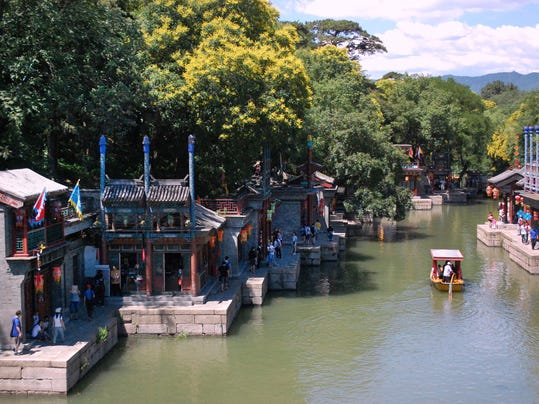Kirsten Jacobsen, Special to the Register; 11:09 p.m. CDT June 21, 2014

(Photo: Kirsten Jacobsen/Photos Special to the Register)
Walking down the city’s bustling hútong — Beijing’s eponymous ancient, winding alleyways — street vendors still hawk scallion pancakes and fresh watermelon; grandparents and neighbors dote on tottering infants; faded, red couplets on banners line the doors of residences, wishing passers-by prosperity and happiness; cars, electric bikes, motos and haphazardly piled wagons line the narrow streets.
As old and new Beijing slowly find a tenuous balance, the city’s nearly 21.2 million residents from the hútong to the towering glass apartments to the small family shops keep characteristically Chinese customs — like the hùtong — alive. No small task, considering humans have called the city home for the last 27,000 years. (It has only served as the capital, though, for about 3,000 of them.)
As one of Beijing’s newest residents and a Des Moines native, I’m back in China, reporting this time from the Middle Kingdom’s capital. Covering everything from Iowa’s agricultural and political prominence in the country to fellow Iowans who have found success here, we’ll take a look at what makes Beijing such an important place and key Iowa partner over the next year. I’ll also be writing about daily life, like working for a Chinese state-sponsored newspaper (which will remain unnamed) and playing on one of Asia’s first roller derby teams.
Compared to my former experiences living in a small, rural town in southern Hunan province, life as a tragically poor Chinese speaker in modern Beijing is almost easy. (Apparently, I learned the hard lessons here last time. Like “don’t fall for the tea ceremony scam” and “don’t assume that blob is tofu.”) The government’s preparation for the 2008 Olympic Games contributed immensely to its internationalization, adding some English words to menus, constructing hundreds of public toilets, embracing (albeit temporarily) reduced-smog living, increasing access to public transportation and so much more.
Not all of the games’ effects on the city, however, were positive. Beijing circa 2014 faces an enduring struggle to preserve and protect its cultural heritage while developing infrastructure. Upon arriving, I spoke with friend and translator Zhang Li Mei, 42, a born Beijinger, to get a better understanding of the changing faces of the Northern Capital.
“In 1990, the winter and summer were short, maybe very hot for one month or very cold. (It was) always very windy, full of sand from the desert. Now already in June, it is so hot,” she said, noting the unseasonably humid 93-degree weather that day. (And it was sunny! Clearly something’s wrong.) In just more than two decades, Beijing’s population boomed from about 10 million in 1990 to more than twice that today — a correlation Zhang attributes directly to the downfall of the region’s climate.
With that population boom, too, came political and economic problems. “During the cultural revolution,” Zhang continued, “my father studied to become a teacher… Those days, where a job was empty, a person was sent to do it. My father was sent (to Beijing) to teach at university.” After the institution of “socialism with Chinese characteristics” (a.k.a. latent capitalism) and other widespread reforms in the early 1980s to 1990s, she said, citizens’ newfound mobility brought them flocking to jobs in the capital city, dreaming of better-paying jobs and greater opportunities.
For detail please visit:http://www.desmoinesregister.com/story/life/2014/06/22/china-beijing-newspaper-modernization-status-quo-kirsten-jacobsen/11105961/
